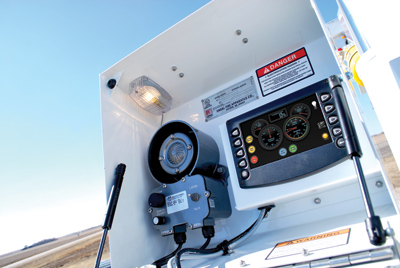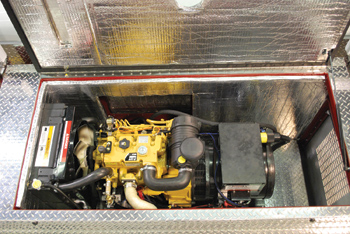Alan M. Petrillo
Smeal Fire Apparatus has introduced several new products to its line of custom manufactured vehicles, including a new private label chassis, an auxiliary power unit (APU), an aerial information display, and higher-psi steel for all its ladders and platforms.
Private-Label Chassis
Smeal’s new chassis is available in Sentron I and II models. The Sentron II is a price-competitive chassis that’s available for small block engines, says Joel Konecky, Smeal’s regional sales director. “It serves as an entry-level apparatus chassis for departments that don’t require a large-horsepower engine,” he states.
Konecky notes that the Sentron II chassis has headroom that runs 62 inches from floor to ceiling in the crew area, is available with different raised roof features, and comes in two models of cab-134 and 148 inches. “We make the Sentron models on our Air Ride cab with stainless steel door panels,” Konecky says, “and with lots of room in the crew area for firefighters and their equipment, as well as up front for the driver and officer.”
The Sentron I chassis, which Smeal expects to be available by the end of this year, has a wider cab and can handle larger water capacities and higher horsepower big block engines.
 |
| (1) Smeal Fire Apparatus debuted a new chassis series in two models: the Sentron I and II. Shown here is the Sentron II, designed as an entry-level apparatus chassis for small block engines. (Photos courtesy of Smeal Fire Apparatus.) |
Aerial Steel
Jeff Hunke, Smeal’s vice president, says that Smeal will now construct its aerials with 100,000-psi yield strength steel, instead of the previously used 70,000-psi steel. He notes that Smeal has been contemplating this change since the EPA 2010 emissions rules “put a lot more weight on the truck, especially on the front, where now there’s about 1,000 pounds more than with pre-2010 engines.”
Konecky notes Smeal has completed the steel change on its 75-foot aerial ladder with a four-stabilizer system. “With our previous design, we had a 500-pound tip load when flowing 1,250 gallons per minute (gpm),” he says. “With the new design, we’ve increased the tip load to 750 pounds and the flow rating to 1,500 gpm.”
Hunke points out that by going to the higher-psi steel, Smeal took a substantial amount of weight out of the aerial structure while still increasing its strength. “We lightened up the completed apparatus substantially and increased the vehicle’s capabilities, allowing fire departments to carry more equipment on the truck or water in the tank.”
 |
| (2) All of the aerial products offered by Smeal Fire Apparatus will have their aerial assemblies redesigned to be constructed of 100,000-psi steel. |
Hunke says Smeal has 13 different aerial ladders and platforms in its product line and expects to have made the design change to the stronger steel in all of them during the next 12 months. “We’re focusing on the most popular models, like the 105-foot rear-mount aerial ladder, which is being done right now,” he says. “Those models have the highest priority.”
Smart Aerials
Smeal has also introduced the AL-11 Aerial Logic system for its aerials. “It’s not only a display, it’s a totally integrated system that uses sensors to get feedback on a ladder’s extension, location, retraction, angle, load and breathing air system status, as well as J1939 engine information,” Konecky says. “It also controls all the functions for lighting on the vehicle.”
 |
| (3) Smeal Fire Apparatus has introduced the AL-11 Aerial Logic system for its aerials, an integrated system that uses sensors to give an operator feedback on all the functions related to the aerial. |
The AL-11 isn’t a touch screen but rather uses tactile screen buttons that allow a firefighter to use the unit while wearing gloves. The screen has day and night modes and is not susceptible to glare, Konecky notes. “It allows the operator the ability to monitor all the critical functions of the aerial and gives a continuous readout of everything that has to do with aerial operations,” he says. “It also integrates all body and cab collision interlocks.”
Green Initiative
To address concerns from fire departments seeking to reduce vehicle operating costs and emissions, Smeal introduced its SG-09 Smeal Green Auxiliary Power Unit. It’s a diesel-driven engine powering a 120-/240-volt AC generator, 12-volt DC alternator, and air conditioning compressor. The APU can serve as a standalone generator as well.
Smeal’s APU integrates with the chassis engine so when the main engine isn’t needed to operate the aerial or to pump water, the APU will automatically shut down the chassis engine and start itself to run all the electrical systems on the vehicle. “Running a small three-cylinder diesel engine significantly reduces greenhouse gases compared to a large apparatus chassis engine,” Konecky says. “It also reduces costs for the fire department because it reduces the amount of time the chassis engine has to idle and the number of times the diesel particulate filter has to regenerate. If you’re already putting a hydraulic generator on an apparatus, this can replace it at a cost that is not significant.”
 |
| (4) Smeal’s new auxiliary power unit (APU) integrates with a vehicle’s chassis engine so when the main engine isn’t needed, the APU automatically starts itself to run all electrical systems and shuts the chassis engine down. |
ALAN M. PETRILLO is a Tucson, Arizona-based freelance writer and is a member of the Fire Apparatus & Emergency Equipment editorial advisory board. He served 22 years with the Verdoy (NY) Fire Department, including in the position of chief.

